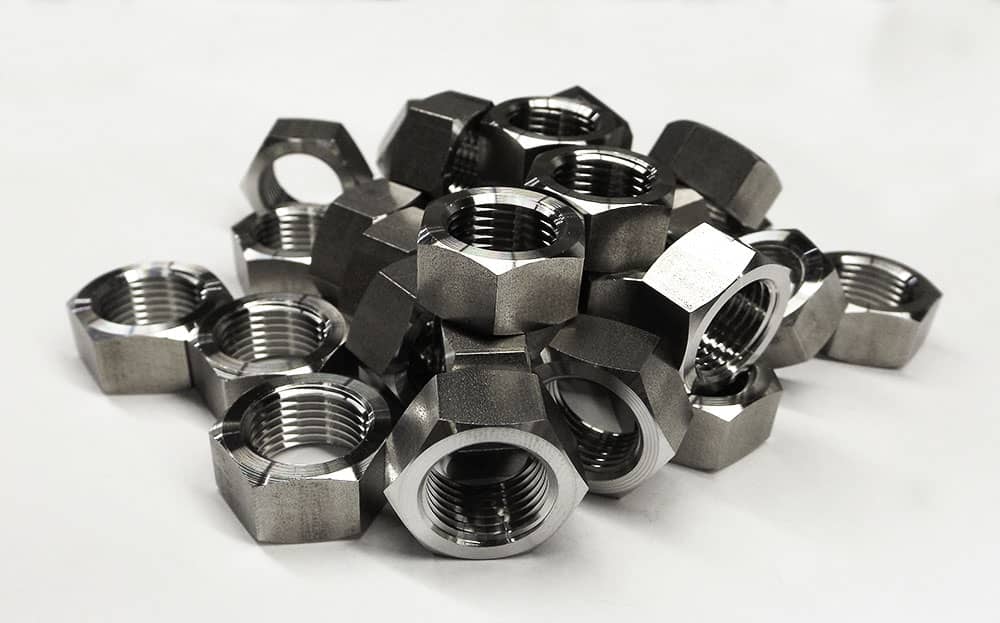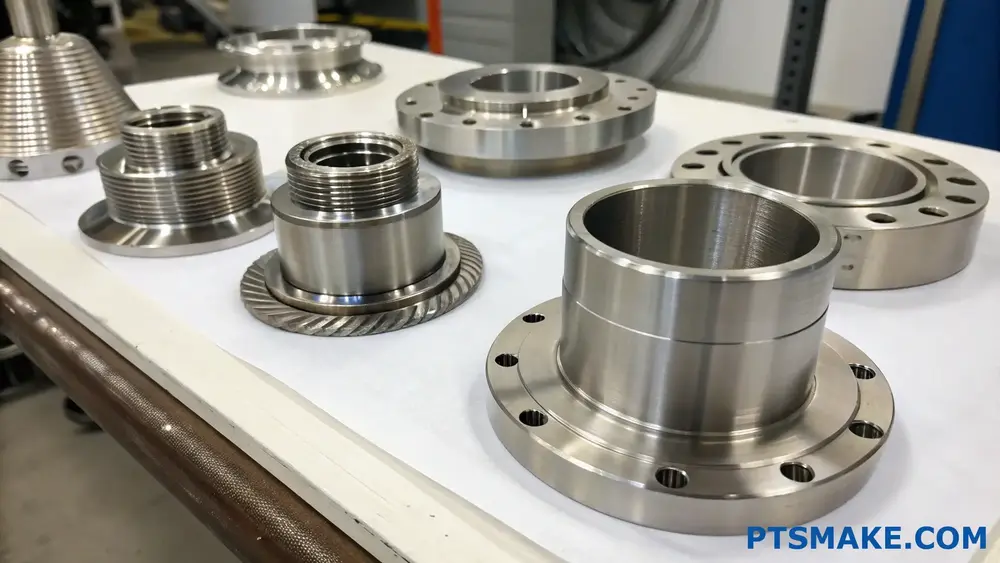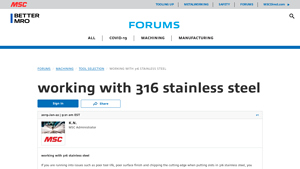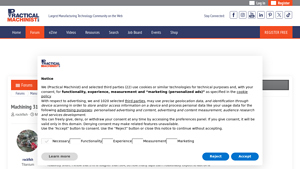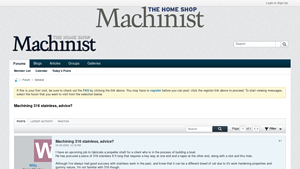Machining 316 Stainless Steel Guide: Type, Cost, Top List…
Introduction: Navigating the Global Market for machining 316 stainless steel
In the competitive landscape of global manufacturing, sourcing reliable suppliers for machining 316 stainless steel poses a significant challenge for B2B buyers. This high-performance alloy, known for its exceptional corrosion resistance and durability, is essential in various industries, from aerospace to medical devices. However, the complexities of its machinability—compounded by factors such as work hardening and the need for specialized tooling—can complicate procurement and production processes.
This comprehensive guide delves into the intricacies of machining 316 stainless steel, offering insights into its various grades, applications, and the latest machining techniques. It also addresses critical aspects such as supplier vetting, cost considerations, and strategies to enhance production efficiency. For international B2B buyers, particularly from regions like Africa, South America, the Middle East, and Europe, this guide empowers informed purchasing decisions by providing actionable advice and expert recommendations.
By equipping buyers with the knowledge necessary to navigate the complexities of sourcing and machining 316 stainless steel, this guide aims to streamline the procurement process and foster successful partnerships. Whether you are a seasoned manufacturer or entering the stainless steel market for the first time, understanding these key elements will ensure you make strategic choices that enhance your operational capabilities and drive business success.
Understanding machining 316 stainless steel Types and Variations
| Type Name | Key Distinguishing Features | Primary B2B Applications | Brief Pros & Cons for Buyers |
|---|---|---|---|
| Standard 316 | Contains molybdenum for enhanced corrosion resistance | Marine, chemical processing, and food industries | Pros: Excellent corrosion resistance; Cons: More difficult to machine compared to 304. |
| 316L (Low Carbon) | Lower carbon content reduces susceptibility to sensitization | Oil and gas, pharmaceuticals, and nuclear applications | Pros: Better weldability; Cons: Slightly lower strength than standard 316. |
| 316H (High Carbon) | Higher carbon content improves high-temperature strength | Aerospace, power generation, and high-temperature applications | Pros: Enhanced strength at elevated temperatures; Cons: More prone to corrosion than 316L. |
| 316Ti (Titanium Stabilized) | Addition of titanium improves resistance to intergranular corrosion | Chemical processing, marine applications | Pros: Better stability at high temperatures; Cons: Higher cost due to alloying elements. |
| 316F (Free Machining) | Enhanced machinability with added sulfur | Precision machining and manufacturing of intricate parts | Pros: Easier to machine; Cons: Reduced corrosion resistance compared to standard 316. |
What Are the Key Characteristics of Standard 316 Stainless Steel?
Standard 316 stainless steel is renowned for its superior corrosion resistance, primarily due to the inclusion of molybdenum. This type is commonly used in marine environments and chemical processing, where exposure to saltwater and aggressive chemicals is frequent. However, its machinability is lower compared to other grades like 304, which can lead to increased production costs. Buyers should consider the balance between corrosion resistance and machining ease when selecting this type for their applications.
How Does 316L Differ in Terms of Suitability and Applications?
316L, with its low carbon content, is particularly advantageous for welding applications as it minimizes the risk of sensitization, which can lead to corrosion. It is widely utilized in the oil and gas industry, pharmaceuticals, and nuclear sectors, where integrity and safety are paramount. While it offers improved weldability, it has slightly lower strength than standard 316. Buyers should assess the need for weldability versus strength when choosing 316L.
What Advantages Does 316H Provide for High-Temperature Applications?
316H is designed for high-temperature applications, making it suitable for industries such as aerospace and power generation. Its higher carbon content enhances strength at elevated temperatures, but this comes at the cost of increased susceptibility to corrosion. This grade is ideal for applications where strength is critical, but buyers must weigh the trade-off in corrosion resistance based on their operational environment.
Why Choose 316Ti for Chemical Processing and Marine Applications?
The addition of titanium in 316Ti provides enhanced resistance to intergranular corrosion, making it a preferred choice for chemical processing and marine applications. This grade is particularly effective in high-temperature environments where stability is crucial. While it offers superior performance, the cost of 316Ti is typically higher due to the alloying elements. Buyers should consider long-term performance versus upfront costs when evaluating this option.
What Makes 316F a Viable Option for Precision Machining?
316F is specifically formulated for improved machinability, making it an excellent choice for precision machining and the manufacturing of intricate parts. The addition of sulfur enhances cutting performance but may reduce corrosion resistance slightly compared to standard 316. This type is ideal for manufacturers looking to optimize production efficiency. However, buyers should evaluate the specific environmental conditions their products will face to ensure appropriate material selection.
Key Industrial Applications of machining 316 stainless steel
| Industry/Sector | Specific Application of machining 316 stainless steel | Value/Benefit for the Business | Key Sourcing Considerations for this Application |
|---|---|---|---|
| Aerospace | Fabrication of aircraft components | High corrosion resistance ensures safety and durability | Compliance with strict aerospace standards and certifications |
| Oil & Gas | Manufacturing of valves and fittings | Enhanced resistance to harsh environments extends equipment lifespan | Need for suppliers with experience in high-pressure applications |
| Marine | Production of marine hardware and equipment | Corrosion resistance in saline environments reduces maintenance costs | Sourcing from manufacturers with proven marine-grade expertise |
| Pharmaceutical | Creation of processing equipment and storage tanks | Ensures hygiene and prevents contamination in sensitive environments | Verification of material certifications and compliance with health regulations |
| Food Processing | Machining of food processing machinery components | Non-reactive properties enhance food safety and quality | Focus on suppliers with experience in food-grade materials |
How is Machining 316 Stainless Steel Utilized in Aerospace Applications?
In the aerospace sector, machining 316 stainless steel is crucial for fabricating components such as brackets, fasteners, and structural parts. The alloy’s exceptional corrosion resistance and strength are vital for maintaining safety and performance at high altitudes. Buyers in this industry must ensure that their suppliers can meet stringent aerospace standards and certifications, as any failure could lead to catastrophic results. Additionally, sourcing from manufacturers experienced in working with high-performance materials is essential for maintaining compliance with industry regulations.
What Role Does Machining 316 Stainless Steel Play in the Oil & Gas Industry?
The oil and gas industry relies heavily on the machining of 316 stainless steel for the production of valves, fittings, and piping systems that withstand high pressures and corrosive environments. The alloy’s ability to resist pitting and crevice corrosion makes it suitable for offshore and subsea applications. B2B buyers must prioritize sourcing from suppliers with a proven track record in high-pressure applications and those who can provide detailed material certifications. This ensures that the components can endure the extreme conditions prevalent in this sector.
Why is Machining 316 Stainless Steel Important in Marine Applications?
Machining 316 stainless steel is essential for manufacturing marine hardware, such as propellers, railings, and fasteners, due to its superior resistance to corrosion in saline environments. This attribute helps reduce the frequency of maintenance and replacement, ultimately lowering operational costs. International buyers in the marine sector should seek suppliers with specific expertise in marine-grade materials and a history of successful projects. Ensuring that products meet maritime standards is vital for maintaining safety and compliance.
How is Machining 316 Stainless Steel Utilized in Pharmaceutical Manufacturing?
In the pharmaceutical industry, machining 316 stainless steel is used to create processing equipment, storage tanks, and other components that require high levels of hygiene and contamination prevention. The material’s non-reactive properties are critical in maintaining the integrity of sensitive products. Buyers need to ensure that their suppliers can provide materials that meet health regulations and possess the necessary certifications. Additionally, sourcing from manufacturers experienced in pharmaceutical applications is crucial for ensuring compliance and quality.
What Benefits Does Machining 316 Stainless Steel Offer in Food Processing?
Machining 316 stainless steel for food processing machinery components is vital due to its non-reactive nature, which enhances food safety and quality. Applications include conveyor systems, mixers, and storage tanks. B2B buyers in this sector should focus on sourcing from suppliers who specialize in food-grade materials and can provide assurance of compliance with health and safety standards. This is particularly important for maintaining consumer trust and meeting regulatory requirements in food production.
3 Common User Pain Points for ‘machining 316 stainless steel’ & Their Solutions
Scenario 1: Difficulty in Managing Work Hardening During Machining
The Problem: One of the most significant challenges faced by B2B buyers when machining 316 stainless steel is the material’s tendency to work harden. This phenomenon occurs when the surface of the material hardens due to the heat generated during machining, making it increasingly difficult to cut through. Buyers may find that their standard machining tools become dull quickly, leading to increased operational costs and longer lead times. Additionally, the harder surface can cause tools to chip or break, resulting in further delays and waste.
The Solution: To effectively manage work hardening, it’s crucial to optimize machining parameters. A practical approach is to reduce the spindle speed by 10-20% while increasing the feed rate. This combination ensures that the cutting tool maintains sufficient pressure to penetrate the metal without merely gliding over the surface. Utilizing high-speed steel (HSS) tools that are kept sharp is essential, but carbide inserts designed for aluminum can offer superior performance due to their razor-sharp edges. Additionally, incorporating a sulfur-based cutting oil can help reduce heat buildup, thereby minimizing the risk of work hardening. By investing in quality tools and fine-tuning machining processes, B2B buyers can significantly enhance productivity and reduce costs associated with machining 316 stainless steel.
Scenario 2: Challenges with Chip Formation and Removal
The Problem: Machining 316 stainless steel often results in problematic chip formation. Unlike softer metals, the chips produced during the machining of stainless steel can be long and stringy, resembling razor wire. This poses a safety hazard for workers and complicates the machining process, as these chips can interfere with machinery, leading to downtime and increased maintenance costs. B2B buyers may struggle to keep their work environment safe and efficient due to these issues.
The Solution: To tackle chip formation challenges, buyers should consider using cutting tools specifically designed for stainless steel. Opting for inserts that promote chip breaking can help manage chip size effectively. Additionally, adjusting the cutting parameters—such as depth of cut and feed rate—can help in producing shorter chips. Implementing a chip management system, such as a chip conveyor or effective coolant flow, can also assist in removing chips from the work area quickly and efficiently. Regular maintenance of machining equipment to prevent chip buildup and ensuring that operators are trained in handling and disposing of chips safely will further enhance workplace safety and operational efficiency.
Scenario 3: Inconsistent Surface Finish Quality
The Problem: Achieving a consistent and high-quality surface finish on machined 316 stainless steel can be a daunting task for many B2B buyers. Variability in machining parameters, tool wear, and material properties can lead to surface imperfections, which are particularly problematic in industries requiring stringent quality standards, such as aerospace and medical manufacturing. Buyers may face challenges in meeting customer expectations, resulting in rework or product returns.
The Solution: To ensure a consistent surface finish, it’s vital to monitor and control machining conditions closely. Implementing a quality control process that includes regular inspections of tool wear can help maintain the integrity of the machining operation. Choosing the right cutting tools is also crucial; using inserts specifically designed for stainless steel can improve surface finish. Furthermore, fine-tuning the feed rate and spindle speed based on the specific job can lead to optimal results. For additional refinement, a secondary finishing process such as polishing or grinding can be employed after the primary machining operation. By focusing on these aspects, B2B buyers can achieve the desired surface finish and enhance their product’s overall quality.
Strategic Material Selection Guide for machining 316 stainless steel
When selecting materials for machining 316 stainless steel, it is essential to consider various options that can complement or enhance the machining process. Here, we analyze four common materials used in conjunction with 316 stainless steel, focusing on their properties, advantages, disadvantages, and implications for international B2B buyers.
What Are the Key Properties of Tooling Materials for Machining 316 Stainless Steel?
1. High-Speed Steel (HSS)
High-speed steel is a popular choice for machining 316 stainless steel due to its ability to withstand high temperatures without losing hardness. HSS tools can maintain sharpness for longer periods, which is crucial when working with materials that tend to work-harden quickly. However, they are less effective at high cutting speeds compared to carbide tools.
- Pros: Cost-effective, good toughness, and ease of sharpening.
- Cons: Lower wear resistance and can lose hardness at elevated temperatures.
- Impact on Application: Suitable for general machining tasks but may require frequent tool changes.
- Considerations for International Buyers: HSS tooling must comply with ASTM standards, and buyers should ensure that suppliers provide quality certifications.
2. Carbide Inserts
Carbide inserts are favored for their exceptional hardness and wear resistance, making them ideal for machining tough materials like 316 stainless steel. They can handle higher speeds and feeds, which can improve productivity. However, carbide tools can be more brittle and may chip under certain conditions.
- Pros: High cutting speeds, excellent surface finish, and reduced tool wear.
- Cons: Higher initial cost and potential brittleness.
- Impact on Application: Ideal for high-volume production where precision and speed are paramount.
- Considerations for International Buyers: Buyers should look for inserts that meet international standards (e.g., ISO, DIN) and consider local availability of specific grades.
3. Lubricants and Coolants
The use of specialized lubricants and coolants is critical when machining 316 stainless steel to reduce friction and heat generation. Sulfur-based cutting oils are often recommended, as they can help prevent work hardening and improve tool life.
- Pros: Enhanced tool life, improved surface finish, and reduced heat buildup.
- Cons: Additional costs and potential environmental regulations regarding disposal.
- Impact on Application: Essential for maintaining machining efficiency and product quality.
- Considerations for International Buyers: Compliance with local environmental regulations is crucial, and buyers should seek eco-friendly options where possible.
4. Coated Tooling
Coated tooling, such as those with titanium nitride (TiN) or aluminum oxide (Al2O3), can significantly enhance the performance of tools used for machining 316 stainless steel. These coatings provide a hard surface that reduces friction and increases wear resistance.
- Pros: Extended tool life, improved cutting performance, and reduced friction.
- Cons: Higher cost and potential for coating wear in extreme conditions.
- Impact on Application: Suitable for demanding applications where tool longevity is critical.
- Considerations for International Buyers: Buyers should verify the coating specifications and ensure they align with industry standards for performance.
Summary Table of Material Selection for Machining 316 Stainless Steel
| Material | Typical Use Case for machining 316 stainless steel | Key Advantage | Key Disadvantage/Limitation | Relative Cost (Low/Med/High) |
|---|---|---|---|---|
| High-Speed Steel (HSS) | General machining tasks | Cost-effective and easy to sharpen | Lower wear resistance | Low |
| Carbide Inserts | High-volume production | High cutting speeds and surface finish | Brittleness under stress | High |
| Lubricants and Coolants | Essential for tool life and efficiency | Enhanced tool life and surface finish | Additional costs | Medium |
| Coated Tooling | Demanding applications requiring tool longevity | Extended tool life and performance | Higher cost | High |
In conclusion, the choice of materials for machining 316 stainless steel can significantly affect the efficiency, cost, and quality of the final product. International B2B buyers should consider the properties, advantages, and limitations of each material while ensuring compliance with local standards and regulations.
In-depth Look: Manufacturing Processes and Quality Assurance for machining 316 stainless steel
What Are the Key Stages in Manufacturing 316 Stainless Steel Parts?
Machining 316 stainless steel involves several critical manufacturing stages, each designed to ensure precision and quality. The main stages are material preparation, forming, assembly, and finishing.
How Is Material Prepared for Machining 316 Stainless Steel?
Material preparation is the first step in the machining process. It involves selecting high-quality 316 stainless steel, which is known for its excellent corrosion resistance and mechanical properties. The material often comes in the form of bars, sheets, or plates. Prior to machining, the material must be cut to size, typically using saws or plasma cutters.
To enhance machinability, especially given 316’s tendency to work harden, it is essential to maintain the integrity of the material. This may involve heat treatment, although 316 is not typically heat-treatable. Instead, manufacturers focus on maintaining a consistent grain structure during the cutting process.
What Techniques Are Used in the Forming Stage for 316 Stainless Steel?
The forming stage encompasses various machining techniques tailored for 316 stainless steel. Common methods include turning, milling, drilling, and grinding.
-
Turning: This process is often used for producing cylindrical components. Given the material’s work-hardening characteristics, using sharp carbide inserts designed for aluminum can significantly improve surface finish and reduce tool wear.
-
Milling: For flat or complex shapes, CNC milling is prevalent. The use of a slower spindle speed (10-20% reduction compared to machining 304 stainless steel) combined with increased feed rates helps manage heat buildup and minimize work hardening.
-
Drilling: When drilling, it’s crucial to use high-quality drill bits designed for stainless steel. Coolants or cutting oils, particularly sulfur-based oils, should be applied to reduce friction and heat.
-
Grinding: Final finishing may involve grinding to achieve high tolerances and surface finishes. This is especially critical in industries like aerospace and pharmaceuticals, where precision is paramount.
How Is Assembly Conducted for Machined 316 Stainless Steel Components?
Assembly may involve welding or fastening machined components. Given 316’s excellent weldability, processes such as TIG (Tungsten Inert Gas) welding are commonly employed. When assembling parts, it’s vital to ensure that the joint design accommodates thermal expansion, as stainless steel can expand and contract significantly with temperature changes.
What Are the Finishing Techniques for 316 Stainless Steel Parts?
Finishing processes enhance the aesthetic and functional properties of machined parts. Techniques may include:
- Polishing: This improves surface finish and corrosion resistance, making it ideal for visible components in consumer products.
- Passivation: A chemical treatment that removes free iron and enhances corrosion resistance.
- Coating: Applying protective coatings can further enhance the resistance to environmental factors, especially in harsh industrial settings.
What Quality Control Measures Are Essential for Machining 316 Stainless Steel?
Quality control (QC) is paramount in ensuring the integrity and performance of machined 316 stainless steel parts. International standards such as ISO 9001 provide a framework for quality management systems, while industry-specific certifications (e.g., CE for Europe, API for the oil and gas sector) ensure compliance with rigorous safety and performance standards.
Which QC Checkpoints Should B2B Buyers Consider?
-
Incoming Quality Control (IQC): This involves inspecting raw materials upon arrival to ensure they meet specified standards. Buyers should request certificates of compliance from suppliers.
-
In-Process Quality Control (IPQC): Continuous monitoring during the machining process is critical. This may include real-time inspections and measurements to ensure adherence to tolerances.
-
Final Quality Control (FQC): Before parts are shipped, a thorough inspection is conducted to verify that all specifications are met. This often includes dimensional checks and surface finish evaluations.
What Testing Methods Are Commonly Used in QC for Machined Parts?
Common testing methods include:
- Dimensional Inspection: Utilizing tools like calipers and micrometers to ensure precise measurements.
- Non-Destructive Testing (NDT): Techniques such as ultrasonic testing and dye penetrant testing can identify internal flaws without damaging the component.
- Tensile and Hardness Testing: These tests determine the mechanical properties of the material, ensuring it meets the required specifications.
How Can B2B Buyers Verify Supplier Quality Control?
B2B buyers, especially those in regions like Africa, South America, the Middle East, and Europe, should adopt several strategies to verify supplier QC:
- Audits: Conducting regular audits of suppliers can provide insights into their quality management practices and adherence to international standards.
- Quality Reports: Requesting detailed QC reports, including inspection and testing data, can help buyers assess the reliability of the supplier’s processes.
- Third-Party Inspections: Engaging independent inspection agencies can provide an unbiased assessment of the supplier’s capabilities and quality assurance measures.
What QC and Certification Nuances Should International B2B Buyers Be Aware Of?
International buyers must be cognizant of varying standards and certifications across regions. For instance, while ISO 9001 is globally recognized, specific industries may have additional requirements. Understanding local regulations and compliance standards is crucial for successful international transactions.
Buyers should also consider logistical factors, such as shipping and handling practices that can impact the integrity of the parts during transit. Ensuring that suppliers have robust packaging and handling protocols is essential for maintaining quality from the factory to the end-user.
In conclusion, understanding the manufacturing processes and quality assurance measures for machining 316 stainless steel is critical for B2B buyers. By ensuring adherence to stringent quality control standards and employing best practices in manufacturing, buyers can achieve superior products that meet their operational needs.
Practical Sourcing Guide: A Step-by-Step Checklist for ‘machining 316 stainless steel’
In the competitive landscape of machining, particularly when working with 316 stainless steel, it’s essential for B2B buyers to have a structured approach to sourcing. This guide provides a practical checklist to help you navigate the procurement process effectively, ensuring that you choose the right materials and suppliers for your machining needs.
Step 1: Define Your Technical Specifications
Understanding the specific requirements for your project is paramount. Clearly outline the dimensions, tolerances, and surface finishes needed for the 316 stainless steel components. This clarity will help you communicate effectively with suppliers and avoid misunderstandings that could lead to costly mistakes.
- Considerations:
- Strength requirements and corrosion resistance levels.
- Any industry-specific standards or certifications that must be met.
Step 2: Identify Reliable Suppliers
Research potential suppliers who specialize in machining 316 stainless steel. Look for companies with proven expertise in working with this specific alloy, as its unique properties can make machining more challenging than other materials.
- Tips:
- Check industry forums and reviews for feedback on supplier performance.
- Look for suppliers with experience in your specific sector (e.g., aerospace, automotive).
Step 3: Verify Supplier Certifications
Before finalizing any agreements, ensure that suppliers have the necessary certifications to work with stainless steel. ISO certifications or adherence to AS9100 standards for aerospace components can indicate a commitment to quality and safety.
- What to look for:
- Certificates confirming compliance with international standards.
- Evidence of quality control processes in place.
Step 4: Request Material Test Reports
When sourcing 316 stainless steel, request material test reports (MTRs) from your suppliers. These documents provide essential information about the chemical composition and mechanical properties of the steel, ensuring it meets your project specifications.
- Key details to confirm:
- Verification of alloy composition (e.g., chromium and molybdenum content).
- Results of tensile strength and corrosion resistance tests.
Step 5: Evaluate Machining Capabilities
Not all suppliers will have the same machining capabilities. Assess whether their equipment and technology can handle the specific requirements of machining 316 stainless steel, including the ability to manage work hardening and achieve desired surface finishes.
- Considerations:
- Availability of advanced machining tools (e.g., CNC machines).
- Experience with the specific machining processes you require (e.g., turning, milling).
Step 6: Discuss Lead Times and Pricing
Engage in discussions about lead times and pricing structures. Understanding the timelines for production and delivery will help you plan your project effectively. Additionally, transparent pricing can prevent unexpected costs down the line.
- Important questions:
- What are the average lead times for your orders?
- Are there any bulk order discounts or financing options available?
Step 7: Establish Clear Communication Channels
Effective communication is crucial throughout the sourcing process. Establish who your primary contact will be and ensure they are accessible for any questions or updates regarding your order.
- Best practices:
- Set regular check-in times for updates on your order status.
- Use project management tools to track progress and facilitate communication.
By following this checklist, B2B buyers can streamline their sourcing process for machining 316 stainless steel, ensuring they partner with the right suppliers and receive the quality materials necessary for their projects.
Comprehensive Cost and Pricing Analysis for machining 316 stainless steel Sourcing
What Are the Key Cost Components in Machining 316 Stainless Steel?
When sourcing for machining 316 stainless steel, it’s essential to understand the various cost components that contribute to the overall pricing structure. Key elements include:
-
Materials: The cost of 316 stainless steel itself is influenced by market conditions, alloy composition, and supplier pricing. Prices can fluctuate based on global demand and the availability of raw materials, making it crucial for buyers to stay updated on market trends.
-
Labor: Skilled labor is necessary for machining stainless steel due to its challenging properties. Labor costs can vary significantly based on the region, expertise required, and the complexity of the machining operation.
-
Manufacturing Overhead: This includes costs related to the operation of machinery, utilities, and facility maintenance. Overhead can also encompass administrative expenses, which can impact the pricing for smaller orders.
-
Tooling: High-quality tooling is vital for effective machining of 316 stainless steel. Tooling costs can vary based on the type of tools (carbide inserts versus HSS tools) and their specific application, especially given that 316 is known for its work-hardening properties.
-
Quality Control (QC): Ensuring that the machined products meet industry standards requires investment in quality control processes. QC costs can include testing, certifications, and compliance with international standards.
-
Logistics: Shipping and handling costs can significantly affect the total cost, especially for international buyers. Factors such as distance, shipping method, and customs duties need to be considered.
-
Margin: Suppliers will typically add a margin to cover their costs and ensure profitability. This can vary based on the supplier’s pricing strategy and market competition.
How Do Price Influencers Affect Machining Costs for 316 Stainless Steel?
Several factors can influence the pricing of machining 316 stainless steel:
-
Volume/MOQ: Higher order volumes often lead to reduced per-unit costs. Suppliers may offer discounts for bulk orders, making it advantageous for buyers to consolidate their purchasing.
-
Specifications and Customization: Custom designs or specifications can increase costs due to the additional labor and tooling required. Buyers should clearly communicate their needs to avoid unexpected expenses.
-
Material Quality and Certifications: The presence of certifications (e.g., ISO, ASTM) can impact pricing. High-quality materials that meet strict standards typically come at a premium, but they ensure reliability and performance.
-
Supplier Factors: Supplier reputation, location, and reliability can also affect pricing. Established suppliers with a history of delivering quality products might charge more but offer greater assurance.
-
Incoterms: The chosen Incoterms (International Commercial Terms) will determine the responsibilities of buyers and sellers in terms of shipping costs, insurance, and liability. Understanding these terms can help in negotiating better deals.
What Tips Can Help Buyers Negotiate Better Pricing for Machining 316 Stainless Steel?
For international B2B buyers, particularly from Africa, South America, the Middle East, and Europe, the following tips can enhance cost-efficiency:
-
Negotiate Volume Discounts: Approach suppliers with a clear understanding of your volume needs. Negotiating for bulk discounts can lead to significant savings.
-
Evaluate Total Cost of Ownership (TCO): Consider not just the upfront costs but also long-term factors such as maintenance, durability, and performance. Choosing higher quality materials may lead to lower overall costs.
-
Be Aware of Pricing Nuances: Understand that machining 316 stainless steel can have varying costs based on regional labor rates, material availability, and supplier competition. Research suppliers in different regions to find competitive pricing.
-
Build Relationships with Suppliers: Establishing long-term partnerships can lead to better pricing and priority service. Suppliers may be more willing to negotiate with trusted clients.
-
Stay Updated on Market Trends: Regularly monitor the steel market and global economic conditions that might impact material costs. Being informed can give buyers leverage during negotiations.
Disclaimer
The pricing and cost analysis provided in this section are indicative and can vary widely based on market conditions, specific supplier practices, and individual project requirements. Buyers are encouraged to conduct their own research and obtain quotes tailored to their specific needs.
Alternatives Analysis: Comparing machining 316 stainless steel With Other Solutions
Introduction to Alternative Solutions for Machining 316 Stainless Steel
When considering the machining of 316 stainless steel, it is essential for B2B buyers to explore alternative materials and methods that may offer similar benefits or improved performance. Each solution has its unique characteristics, advantages, and potential drawbacks. This comparison will provide insights into how machining 316 stainless steel stacks up against other viable options, enabling buyers to make informed decisions based on their specific needs.
| Comparison Aspect | Machining 316 Stainless Steel | Alternative 1: Machining 304 Stainless Steel | Alternative 2: Machining Carbon Steel |
|---|---|---|---|
| Performance | High corrosion resistance; suitable for marine and chemical environments | Good corrosion resistance; less than 316 | Moderate corrosion resistance; strong and tough |
| Cost | Generally higher due to alloying elements and complexity | Lower than 316; more cost-effective | Generally the least expensive option |
| Ease of Implementation | More challenging due to work hardening; requires sharp tools and specific techniques | Easier to machine; less work hardening | Easy to machine; standard techniques apply |
| Maintenance | Requires careful handling to prevent rust; may need special lubricants | Less maintenance; more forgiving in handling | Low maintenance; typically durable |
| Best Use Case | Ideal for high-stress, corrosive environments (e.g., marine applications) | Suitable for moderate corrosive environments (e.g., food processing) | Best for structural applications where corrosion is not a primary concern |
Pros and Cons of Alternatives
What are the advantages and disadvantages of machining 304 stainless steel?
Machining 304 stainless steel is often seen as a more cost-effective solution compared to 316. It offers decent corrosion resistance and is easier to machine, making it a popular choice for various applications in food processing and general manufacturing. However, its lower resistance to chloride-induced corrosion makes it less suitable for marine environments or applications exposed to harsh chemicals. Therefore, while 304 is easier to work with, it may not provide the long-term durability required in more demanding situations.
How does machining carbon steel compare?
Machining carbon steel is generally the simplest and most cost-effective option available. It is easier to machine and does not suffer from the work hardening issues associated with stainless steels. Carbon steel is known for its strength and versatility, making it a popular choice for structural applications. However, it lacks the corrosion resistance of stainless steels, which can lead to rust and degradation in moisture-rich environments. Thus, while carbon steel is economical and easy to work with, it may not be suitable for applications where corrosion is a concern.
Conclusion: How to Choose the Right Machining Solution?
In choosing the right machining solution, B2B buyers should consider their specific application requirements, including environmental conditions, budget constraints, and performance needs. Machining 316 stainless steel is ideal for applications requiring high corrosion resistance and strength, especially in harsh environments. However, if cost and ease of machining are more critical, alternatives like 304 stainless steel or carbon steel may be more appropriate. Analyzing the pros and cons of each option will help buyers make informed decisions that align with their operational goals and the demands of their industry.
Essential Technical Properties and Trade Terminology for machining 316 stainless steel
What Are the Essential Technical Properties for Machining 316 Stainless Steel?
When machining 316 stainless steel, understanding its specific properties is crucial for achieving optimal results. Below are several key specifications that are particularly important for B2B buyers in the machining industry.
1. Material Grade: 316 Stainless Steel
316 stainless steel is an austenitic alloy known for its excellent corrosion resistance, particularly against chlorides. This makes it suitable for marine environments, chemical processing, and medical applications. For B2B buyers, selecting the right material grade ensures that the final product meets performance requirements and regulatory standards.
2. Tolerance
Tolerance refers to the allowable variation in a manufactured part’s dimensions. In machining 316 stainless steel, maintaining tight tolerances is critical to ensure that components fit properly and function as intended. High precision can reduce the need for further adjustments or rework, thereby saving time and costs in production.
3. Hardness
The hardness of 316 stainless steel typically ranges between 70-90 HRB (Rockwell Hardness Scale). This property affects the machinability of the material; harder materials can be more challenging to cut and shape. For B2B buyers, understanding hardness levels helps in selecting the appropriate cutting tools and machining processes to enhance efficiency and minimize wear.
4. Machinability Rating
316 stainless steel has a machinability rating of approximately 40% compared to free-machining steel. This means that it requires more effort and specialized techniques to machine effectively. For buyers, this rating is essential for budgeting and resource allocation, as it influences machining time and tool costs.
5. Thermal Conductivity
The thermal conductivity of 316 stainless steel is relatively low, which can lead to heat buildup during machining. This property necessitates the use of effective cooling methods, such as cutting fluids, to prevent work hardening and maintain tool life. B2B buyers should consider this when planning machining operations to ensure efficient production cycles.
6. Yield Strength
The yield strength of 316 stainless steel is around 290 MPa (megapascals), indicating its ability to withstand deformation under load. This property is vital for applications requiring structural integrity. Understanding yield strength helps buyers assess the suitability of materials for specific applications and ensures that components can handle operational stresses.
What Are Common Trade Terminology and Jargon in Machining?
Navigating the world of machining involves familiarizing oneself with specific industry terminology. Here are some common terms that B2B buyers should know:
1. OEM (Original Equipment Manufacturer)
OEM refers to a company that produces parts or equipment that may be marketed by another manufacturer. For buyers, partnering with OEMs can ensure high-quality components that meet specific industry standards.
2. MOQ (Minimum Order Quantity)
MOQ is the smallest number of units a supplier is willing to sell. This term is critical for buyers as it impacts inventory management and overall production costs. Understanding MOQ can help in negotiating better terms with suppliers.
3. RFQ (Request for Quotation)
An RFQ is a document issued by a buyer to solicit price quotes from suppliers for specific products or services. It is a vital tool in procurement, enabling buyers to compare pricing and terms across different suppliers.
4. Incoterms (International Commercial Terms)
Incoterms are internationally recognized rules that define the responsibilities of buyers and sellers in international transactions. Familiarity with Incoterms is crucial for B2B buyers to understand shipping costs, risks, and delivery obligations.
5. Tolerance Level
As mentioned earlier, tolerance level specifies the permissible limits of variation in a physical dimension. For buyers, knowing the tolerance level required for a project can help in selecting the right manufacturing processes and ensuring product quality.
6. Chip Formation
Chip formation refers to the process of material removal during machining, where the removed material forms chips. Understanding chip formation is essential for optimizing cutting conditions and improving surface finish, which can impact product performance and durability.
By grasping these technical properties and trade terminologies, B2B buyers can make informed decisions when sourcing machining services for 316 stainless steel components. This knowledge not only aids in selecting the right suppliers but also enhances the overall efficiency and effectiveness of manufacturing operations.
Navigating Market Dynamics and Sourcing Trends in the machining 316 stainless steel Sector
What Are the Current Market Dynamics and Key Trends in Machining 316 Stainless Steel?
The machining sector for 316 stainless steel is experiencing robust growth driven by its exceptional corrosion resistance, making it ideal for industries such as aerospace, marine, and pharmaceuticals. Global demand for high-performance materials is escalating, particularly in emerging markets across Africa, South America, the Middle East, and Europe. For instance, Brazil’s burgeoning manufacturing sector and Saudi Arabia’s Vision 2030 initiative are likely to boost the demand for precision-engineered components, including those made from 316 stainless steel.
Technological advancements are also shaping the landscape, with the integration of CNC machining and automated processes enhancing efficiency and precision. Buyers are increasingly turning to suppliers who offer advanced machining capabilities, such as 5-axis machining, which allows for intricate designs and reduced lead times. Furthermore, the adoption of Industry 4.0 technologies, including IoT and AI, is enabling real-time monitoring of production processes, ensuring quality control and optimizing resource utilization.
Emerging trends also reflect a growing focus on customization and short lead times. International buyers are seeking suppliers who can provide tailored solutions to meet specific requirements, thus driving the demand for versatile machining services. As a result, suppliers that can quickly adapt to market needs and offer flexible production capabilities will be well-positioned to capture market share.
How Does Sustainability and Ethical Sourcing Impact the Machining of 316 Stainless Steel?
Sustainability has become a crucial consideration in the machining of 316 stainless steel. The environmental impact of production processes is under scrutiny, prompting buyers to prioritize suppliers who adhere to sustainable practices. Ethical sourcing is not merely a trend but a necessity, as companies face increasing pressure to demonstrate corporate social responsibility and reduce their carbon footprints.
Buyers should look for suppliers that implement eco-friendly practices, such as using biodegradable cutting fluids and recycling metal scraps. Additionally, obtaining materials from suppliers with recognized sustainability certifications—such as ISO 14001 for environmental management—can enhance a company’s reputation and meet regulatory requirements.
Green certifications and materials are gaining traction in the machining sector. The use of recycled stainless steel, for instance, reduces energy consumption and waste generation during production. By prioritizing sustainable sourcing, B2B buyers can not only mitigate their environmental impact but also appeal to a growing base of eco-conscious customers.
What Is the Historical Context of Machining 316 Stainless Steel?
The evolution of 316 stainless steel machining is closely tied to advancements in metallurgy and machining technologies. Initially developed in the early 20th century, 316 stainless steel emerged as a response to the demand for materials that could withstand harsh environments, particularly in chemical processing and marine applications. Its enhanced corrosion resistance, attributed to the addition of molybdenum, made it a preferred choice over its predecessor, 304 stainless steel.
As machining technologies progressed, particularly with the advent of CNC machining in the late 20th century, the ability to work with 316 stainless steel improved significantly. These technological advancements allowed for greater precision and efficiency, enabling manufacturers to produce complex components that meet stringent industry standards. Today, 316 stainless steel remains a cornerstone material in various sectors, thanks to its durability and performance in demanding applications.
In summary, understanding the current market dynamics, sustainability practices, and historical context surrounding the machining of 316 stainless steel is essential for B2B buyers seeking to make informed sourcing decisions in a competitive landscape.
Frequently Asked Questions (FAQs) for B2B Buyers of machining 316 stainless steel
-
How do I solve machining difficulties with 316 stainless steel?
Machining 316 stainless steel can be challenging due to its propensity to work harden. To mitigate this, ensure your tooling is sharp and well-maintained. Utilize carbide inserts designed for aluminum, which can provide a better cutting edge. Adjust your machine settings by reducing the RPM by 10-20% while increasing the feed rate. Additionally, using a good quality cutting oil can help control heat build-up and improve surface finish. -
What is the best tool material for machining 316 stainless steel?
Carbide tools are generally the best choice for machining 316 stainless steel due to their hardness and heat resistance. Specifically, select inserts designed for aluminum machining as they feature sharper edges, enhancing performance. HSS tools can be used, but they may dull quicker and require more frequent replacement. Always keep tools sharp and consider using specialized lubricants to reduce friction and improve cutting efficiency. -
What should I consider when sourcing suppliers for 316 stainless steel machining?
When sourcing suppliers, evaluate their experience with 316 stainless steel specifically. Look for certifications in quality management systems, such as ISO 9001, which indicate adherence to high manufacturing standards. Assess their machinery capabilities and ask for samples or references from previous clients. Additionally, consider their geographical location for logistics efficiency and potential tariffs or trade regulations that may impact costs. -
What are typical minimum order quantities (MOQs) for machining 316 stainless steel parts?
Minimum order quantities can vary significantly among suppliers, often ranging from 100 to 1,000 units depending on the complexity of the parts and the supplier’s capabilities. Smaller, specialized suppliers may accommodate lower MOQs, while larger manufacturers may require higher volumes to justify setup costs. Discuss your specific needs with potential suppliers to find a mutually agreeable MOQ. -
What payment terms should I expect when sourcing 316 stainless steel machining services?
Payment terms can vary widely based on the supplier and the nature of your agreement. Common practices include upfront deposits of 30-50% with the balance due upon completion or delivery. Some suppliers may offer net 30 or net 60 terms, especially for established relationships. Always clarify payment terms in the contract to avoid misunderstandings and ensure smooth transactions. -
How can I ensure quality assurance (QA) in my 316 stainless steel machining projects?
To ensure quality assurance, establish clear specifications and tolerances at the outset of the project. Request documentation of the supplier’s QA processes, including inspections and testing methods. Consider conducting periodic audits or requesting samples throughout the production run. Incorporating third-party inspections can also provide additional assurance of quality, particularly for critical applications. -
What logistics considerations should I keep in mind when importing machined 316 stainless steel parts?
When importing machined parts, consider shipping costs, lead times, and customs regulations. Understand the import duties applicable to stainless steel products in your country and factor these into your total cost. Work with suppliers who can provide accurate shipping timelines and documentation to facilitate customs clearance. Additionally, consider using a freight forwarder to streamline the logistics process. -
What are the common applications for machined 316 stainless steel parts in international markets?
Machined 316 stainless steel is widely used in industries such as aerospace, marine, pharmaceuticals, and food processing due to its excellent corrosion resistance and strength. Applications include valves, pumps, fittings, and marine hardware. Understanding the specific needs of your target industry can help you identify potential markets and tailor your product offerings accordingly.
Important Disclaimer & Terms of Use
⚠️ Important Disclaimer
The information provided in this guide, including content regarding manufacturers, technical specifications, and market analysis, is for informational and educational purposes only. It does not constitute professional procurement advice, financial advice, or legal advice.
While we have made every effort to ensure the accuracy and timeliness of the information, we are not responsible for any errors, omissions, or outdated information. Market conditions, company details, and technical standards are subject to change.
B2B buyers must conduct their own independent and thorough due diligence before making any purchasing decisions. This includes contacting suppliers directly, verifying certifications, requesting samples, and seeking professional consultation. The risk of relying on any information in this guide is borne solely by the reader.
Top 7 Machining 316 Stainless Steel Manufacturers & Suppliers List
1. Hobby Machinist – 316 Stainless Steel Machining Tips
Domain: hobby-machinist.com
Registered: 2010 (15 years)
Introduction: 316 stainless steel is more difficult to machine than 304 stainless steel due to its tendency to work harden quicker. Recommended machining practices include using sharp tooling, slowing RPMs by 10-20%, increasing feed rates, and utilizing quality cutting oils. For threading, a new and sharp round cutting die is advised. Chips from 316 can be difficult to break and may form sharp edges, requiring …
2. MSC Direct – 5/8 Cobalt Endmill
Domain: mscdirect.com
Registered: 1996 (29 years)
Introduction: 5/8″ diameter cobalt endmill; recommended coatings: TiCN or TiAlN; sharp cutting edges; light but deep cuts; use of coolant and lubricants in large quantities.
3. Practical Machinist – Machining Stainless Steel
Domain: practicalmachinist.com
Registered: 2000 (25 years)
Introduction: 316 Stainless Steel, machining characteristics, OSG Exopipe taps, flooded cutting oil, Tap Magic Extra Thick, 3/4 NPT tapped hole, bandsaw (Rockwell/Delta) with 1/2″ blades, recommended speeds and feeds: 635-650 SFM for roughing, 70 SFM for drilling, 100-125 SFM for single pointing, recommended inserts: Sumi AC30M, Seco TM200, MolyDee cutting oil, tapered reamer for NPT, tool life expectations: 2 …
4. Homeshop Machinist – 316 Stainless Steel Shaft
Domain: bbs.homeshopmachinist.net
Registered: 2000 (25 years)
Introduction: 316 stainless steel, 6 ft long, requires a key way at one end, taper at the other end, slot and thru hole. Machining advice includes using carbide tooling, slower speeds than recommended SFM, fast and constant feed, and lots of coolant. Recommended cutting fluids include Anchor Lube and previously used “Trim Tap heavy medium” (now discontinued).
5. JBC Machine – 316 Stainless Steel Solutions
Domain: jbcmachine.com
Registered: 2010 (15 years)
Introduction: 316 stainless steel is known for its excellent corrosion resistance, particularly in marine environments. It contains molybdenum, which enhances its resistance to pitting and crevice corrosion. The machining techniques for 316 stainless steel include using high-speed steel or carbide tools, maintaining proper cutting speeds, and utilizing coolant to manage heat. The material is also non-magnetic a…
6. Cox Manufacturing – 316 Stainless Steel Swiss Machined Parts
Domain: coxmanufacturing.com
Registered: 2003 (22 years)
Introduction: 316 Stainless Steel Swiss Machined Parts from Cox Manufacturing Company. Ideal for parts requiring heat and corrosion resistance. Higher corrosion resistance than 304 stainless steel. Non-magnetic. Machining cost factor of 5.6 compared to steel 12L14. Recommended for welding; fair hot forming capabilities. Readily cold worked with recommended annealing to remove stresses. Common applications inclu…
7. Machining Doctor – Austenitic Stainless Steel
Domain: machiningdoctor.com
Registered: 2020 (5 years)
Introduction: {“Material Group”:”M – Stainless Steel”,”Sub-Group”:”Austenitic Stainless Steel”,”Tensile Strength”:”510-710 [N/mm^2]”,”Machinability”:”40%”,”Chemical Composition”:”17% chromium, 13% nickel, 0.08% carbon”,”Corrosion Resistance”:”High, especially in chloride environments”,”Applications”:”Food preparation equipment, laboratory devices, chemical containers, fasteners, heat exchangers”,”Variations”:[{…
Strategic Sourcing Conclusion and Outlook for machining 316 stainless steel
Strategic sourcing in the machining of 316 stainless steel is crucial for optimizing manufacturing processes and enhancing product quality. As highlighted, this material, while highly resistant to corrosion and heat, presents challenges due to its propensity to work harden. B2B buyers must prioritize suppliers that utilize advanced machining techniques and high-quality tooling to mitigate these issues. Investing in sharp, specialized cutting tools and effective lubrication systems can significantly improve efficiency and reduce production costs.
Moreover, understanding the unique properties of 316 stainless steel is essential for making informed decisions. This knowledge enables buyers to collaborate effectively with machining partners, ensuring that the right processes are employed for their specific applications.
Looking ahead, international buyers, particularly from Africa, South America, the Middle East, and Europe, should actively seek out innovative machining solutions and strategic partnerships. By leveraging the latest technologies and best practices in stainless steel machining, businesses can enhance their competitiveness in the global market. Embrace this opportunity to refine your sourcing strategies and connect with suppliers who can meet your machining needs with precision and reliability.
